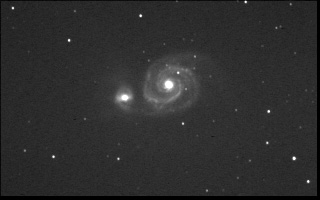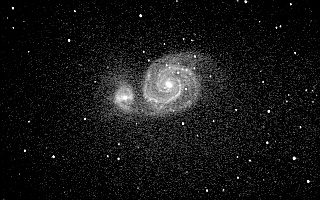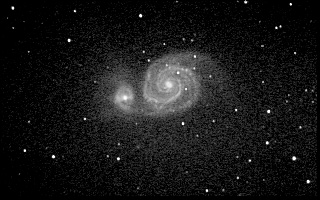|
The Example: The images below represent the galaxy Messier 51 "The Whirlpool Galaxy" and are used to illustrate the benefits of stacking images to increase photographic signal to noise ratio.
These are each raw CCD images taken using the SBIG STV CCD camera on a Takahashi FSQ-106N - 4" refractor. |
|
| RAW IMAGES | |
 |
 |
|
Exposure: 4 x 90 Seconds, SBIG STV Using Track and Accumulate |
Exposure: 3 x 90 Seconds, SBIG STV Using Track and Accumulate |
 |
 |
|
Exposure: 1 x 120 Seconds SBIG STV - The streaks were caused by an airplane |
Exposure: 3 x 120 Seconds, SBIG STV Using Track and Accumulate |
| STACKED IMAGES | |
 |
 |
|
|
|
| Median vs. Sum Stacking: These results are interesting and illustrate two points. While reduction in noise is not immediately visible, if you examine the background you will see it is smoother than the above raw images for both types of combining. However, close examination of the sum combined image reveals a significantly smoother background than the median combined image. Note: Of note is the fact that the median combined images have averaged out the airplane trails visible in image 3 while the sum combined image still show these trails. Understanding the characteristics of each respective stacking process can be very helpful while processing. |
|
| PROCESSED IMAGES - THE RESULTS | |
 |
Image 1 Processed without Stacking This image is processed without the benefit of image stacking to reduce noise. Significant noise is revealed as the image is stretched using digital development processing (DDP) to enhance contrast and sharpness. |
 |
Median Combined and Processed This image benefits from median combined image stacking. A significant reduction in noise is obvious and because of the averaging nature of this type of stacking, the airplane streaks have disappeared as the image is stretched using DDP to enhance contrast and sharpness. |
 |
Sum Combined and Processed Here you can see there is a maximum reduction in noise, but the airplane streaks remain as the image is stretched using DDP to enhance contrast and sharpness. |
|
The Finished Images show how a moderate application of DDP using MaximDL can be used, beneficially, to equalize or stretch image brightness. Faint regions of the image are enhanced while the very much brighter central core is reduced in brightness, and thus reveals detail unseen in the raw images. While the detail in the un-stacked image is made more visible by this processing, the image becomes very noisy. By stacking sufficient numbers of images one can effectively increase the exposure time, greatly decrease noise and therefore increase the signal to noise ratio. This simple example clearly illustrates the well known benefit of image stacking, and how this technique can greatly enhance photographic image quality by increasing signal and reducing noise. |
|
|
|
|
|
Home - WhirlpoolGalaxy.com |
|